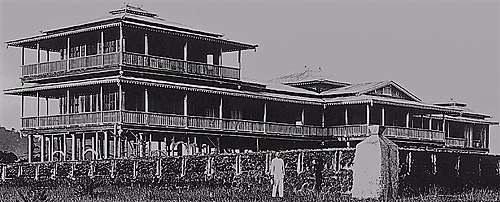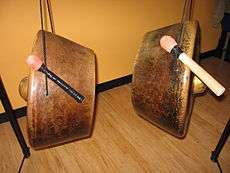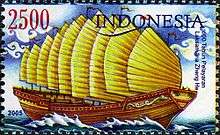Islam in the Philippines
Islam is the first-recorded monotheistic religion in the Philippines. Islam reached the Philippines in the 13th century with the arrival of Muslim traders from the Persian Gulf, Southern India, and their followers from several sultanate governments in the Malay Archipelago. The Muslim population of the Philippines has been reported as about 6% of the total population as of a census in 2000.[1] According to a 2015 report of Philippine Statistics Authority, 6% of Filipinos are Muslims.[2] While the majority of the population are Catholics, some ethnic groups are Hindus, Buddhists, Animists, Sikhs, or non-religious.
According to national religious surveys, there are about 5.1 million Muslims in the Philippines, composing 6% of its population. However, a 2012 estimate by the National Commission on Muslim Filipinos (NCMF) and the U.S. Department of State, stated that there were 10.7 million Muslims, or approximately 11% of the total population.[3][4] Most Muslims live in parts of Mindanao, Palawan, and the Sulu Archipelago – an area known as Bangsamoro or the Moro region.[5] Some have migrated into urban and rural areas in different parts of the country. Most Muslim Filipinos practice Sunni Islam according to the Shafi'i school.[6] There are some Ahmadiyya Muslims in the country.[7]
Islam arrived in the southern islands of Philippines, from the historic interaction of Mindanao and Sulu regions with other Indonesian islands, Malay islands and Borneo. The first Muslims to arrive were traders followed by missionaries in the late 14th and early 15th centuries.[8] They facilitated the formation of Sultanates and conquests in Mindanao and Sulu.[9] The people who converted to Islam came to be known as the Moros. The Muslim conquest reached as far as the Kingdom of Tondo which was supplanted by Brunei's vassal-state the Kingdom of Maynila.[10] Muslim Sultanates had begun expanding in central Philippines in the 16th century, when the Spanish fleet led by Ferdinand Magellan arrived in the Philippines.[11] The Spanish conquest during the 16th century led to Roman Catholicism becoming the dominant religion in most of the Philippines, and Islam a minority religion.[12][13]
History
In 1380 Karim Al Makhdum the first Arabian trader reached the Sulu Archipelago and Jolo in the Philippines and established Islam in the country through trade in several regions of the island. In 1390 the Minangkabau's Prince Rajah Baguinda and his followers preached Islam on the islands.[14] The Sheik Karimal Makdum Mosque was the first mosque established in the Philippines on Simunul in Mindanao in the 14th century. Subsequent settlements by Indian Muslim missionaries traveling to Malaysia and Indonesia helped strengthen Islam in the Philippines and each settlement was governed by a Datu, Rajah and a Sultan. Islam was introduced by Chinese Muslims, Indian Muslims, and Persians. Islamic provinces founded in the Philippines included the Sultanate of Maguindanao, Sultanate of Sulu, Sultanate of Lanao and other parts of the southern Philippines.
When the Spanish fleet led by Miguel López de Legazpi arrived in the Philippines in 1565, they were met by local datus as they traveled in the islands. Arriving in the Kingdom of Maynila, a vassal-state of the Sultanate of Brunei, in 1570 they were met by the Muslim rajah, Rajah Sulaiman III.
By the next century conquests had reached the Sulu islands in the southern tip of the Philippines where the population was Buddhist and Hindu and they took up the task of converting the animistic population to Islam with renewed zeal. By the 15th century, half of Luzon (Northern Philippines) and the islands of Mindanao in the south had become subject to the various Muslim sultanates of Borneo and much of the population in the almost of South were converted to Islam. However, the Visayas was largely dominated by Hindu-Buddhist societies led by rajahs and datus who strongly resisted Islam. One reason could be the economic and political disasters preeuropean Muslim pirates from the Mindanao region brought during raids. These frequent attacks gave way to naming present-day Cebu as then-Sugbo or scorched earth which was a defensive technique implemented by the Visayans so the pirates had nothing much to loot.[15][16]
Invasion of Bruneian Sultanate
In the year 1498–99, the Bruneian Empire conducted a series of raids against the natives of the Kingdom of Taytay in Palawan and the island of Mindoro which had been subjugated to the Islamic Bruneian Empire under Sultan Bolkiah. The Muslim conquest reached as far as the Kingdom of Tondo which was supplanted by Brunei's vassal-state the Kingdom of Maynila.[17][18]
.png)
The Muslim Bruneian Empire under the rule of Sultan Bolkiah, who is an ancestor of the current Sultan of Brunei subjugated the Kingdom of Tondo which was ruled by Rajah Sukwu during 1500. The aftermath of the battle was the formation of an alliance between the newly established Kingdom of Guihulngan (Selurong) and the Sultanate of Brunei, to crush the power of the Kingdom of Tondo and the subsequent installation of the Pro-Islamic Rajah Sulaiman into power. Furthermore, Sultan Bolkiah's victory over Sulu and Seludong (modern day Manila),[19] as well as his marriages to Laila Mecanai the daughter of Sulu Sultan Amir Ul-Ombra (an uncle of Sharifa Mahandun married to Nakhoda Angging or Maharaja Anddin of Sulu), and to the daughter of Datu Kemin, widened Brunei's influence in the Philippines.[20]
A new dynasty began under a local Lumad leader who accepted Islam and became Rajah Salalila or Rajah Sulayman I. He also started to established a trading challenge to the already rich House of Rajah Lakandula in Tondo. Islam was further strengthened by the arrival of Muslim traders and from Jolo, Mindanao, Malaysia and Indonesia.[21]
Rajah Suleyman and Rajah Matanda in the south (now the Intramuros district) were installed as Muslim rajas by converted Muslims and the Buddhist-Hindu settlement was under Raja Lakandula in northern Tundun (now Tondo.)[22]
Influences of Zheng He's voyages
The Chinese Muslim mariner Zheng He is credited with founding several Chinese Muslim communities in Mandaue and along the shores of Lapu-lapu, the Bohol Peninsula, and the Philippines during China's early Ming dynasty. These Muslims supposedly followed the Badjao school in the Chinese language.[23] This Chinese Muslim community was led by Hajji Yan Ying Yu, who urged his followers to assimilate and take local names.
Spanish encounter
Rajah Sulayman was the Rajah of Maynila, a kingdom at the mouth of the Pasig River where it meets Manila Bay, at the time the Spanish forces first came to Luzon.[24][25][26]
Sulayman resisted the Spanish forces, and thus, along with Rajah Matanda and Lakan Dula, was one of three Rajahs who played significant roles in what was the Spanish conquest of their kingdoms of the Pasig River delta in the early 1570s.[27]
Moro (derived from the Spanish word meaning Moors) is the appellation inherited from the Spaniards, for Filipino Muslims of Mindanao. The Muslims seek to establish an independent Islamic province in Mindanao to be named Bangsamoro. The term Bangsamoro is a combination of an Old Malay word meaning nation or state with the Spanish word Moro which means Muslim. A significant Moro Rebellion occurred during the Philippine–American War. Conflicts and rebellion have continued in the Philippines from the pre-colonial period up to the present. Other related issue with the Moro secession is the territorial dispute of eastern Sabah in Malaysia which claimed by the Sultanate of Sulu as their territory.
The Moros have a history of resistance against Spanish, American, and Japanese rule for over 400 years. The violent armed struggle against the Spanish, Americans, Japanese and Filipinos is considered by current Moro (Muslim) leaders as part of the four centuries long "national liberation movement" of the Bangsamoro (Muslim Nation).[28] The 400-year-long resistance against the Japanese, Filipinos, Americans, and Spanish by the Moro/Muslims persisted and morphed into their current war for independence against the Philippine state.[29]
There is also a growing community of Filipino converts to Islam known popularly as Balik Islam (return or returnees to Islam), often led by former Christian missionary converts.[30][31][32][33]

Modern age
In 2012, research was conducted on various cultural properties in Islamic areas in Mindanao. The research included the 'Maradika' Qur'an of Bayang, description of the notes found in the Qur'an of Bayang, the Qur'an and Islamic manuscripts of the Sheikh Ahmad Bashir collection, the 'Dibolodan' Qur'an of Bacong in Marantao, the Qur'an and prayer scroll of Guro sa Masiu in Taraka, the 'Story of the Prophet Muhammad' at the Growing Memorial Research Center of the Dansalan College, and the Islamic Manuscript Art of the Philippines. In 2014, the Maradika Qur'an of Bayang was declared as a National Cultural Treasure, the first Islamic manuscript in the Philippines to be declared as such.[38][39]
Bangsa Sug and Bangsa Moro
In 2018, a unification gathering of all the sultans of the Sulu archipelago and representatives from all ethnic communities in the Sulu archipelago commenced in Zamboanga City, declaring themselves as the Bangsa Sug peoples and separating them from the Bangsa Moro peoples of mainland central Mindanao. They cited the complete difference in cultures and customary ways of life as the primary reason for their separation from the Muslims of mainland central Mindanao. They also called the government to establish a separate Philippine state, called Bangsa Sug, from mainland Bangsa Moro or to incorporate the Sulu archipelago to whatever state is formed in the Zamboanga peninsula, if ever federalism in the Philippines is approved in the coming years.[40]
Bangsamoro Region
Most Muslims in the Philippines live on the island of Mindanao, the Sulu Archipelago and Palawan. The Bangsamoro Autonomous Region in Muslim Mindanao (BARMM) is the region of the Philippines that is composed of all the Philippines' predominantly Muslim provinces, namely: Basilan (except Isabela City), Lanao del Sur, Maguindanao, Sulu and Tawi-Tawi. It also comprised the cities of Marawi, Lamitan, and Cotabato City and the 63 Barangays in North Cotabato who opted to join the autonomous region. It is the only region that has its own government. The regional capital is at Cotabato City, which is outside the jurisdiction of the former and defunct Autonomous Region in Muslim Mindanao (ARMM) but is now part of the Bangsamoro region after the majority of the residents voted in favor for their inclusion in the autonomous region in the ratification of the Bangsamoro Organic Law on January 21, 2019.[41]
Other provinces and regions with large Muslim populations as well have a significant history with Moro/Muslims include North Cotabato, Bicol Region, Eastern Visayas, South Cotabato, Sultan Kudarat and the Zamboanga Peninsula. However, these are not part of the Bangsamoro region.
Traditional art from the Philippines by Muslim groups
- An Indigenous tribal food jar known as gadur, well known for its brass with silver inlay
- A chest made of wood and bone inlay
%2C_Mindanao%2C_wood%2C_Honolulu_Museum_of_Art.jpg) Kutiyapi the native boat-shaped lute of the archipelago
Kutiyapi the native boat-shaped lute of the archipelago- Saddle panel, wood with shell inlay
- Saddle panel, wood with shell inlay
- Kubing (native jaw harp) handle, horn with brass studs
 Agung - large bass nipple-gongs native to the Philippines, and other parts of Maritime Southeast Asia
Agung - large bass nipple-gongs native to the Philippines, and other parts of Maritime Southeast Asia
Notable Muslims
- Rajah Sulaiman I
- Nur Misuari
- Rashid Lucman
- Robin Padilla
- Nina Rasul
- Abu Sabaya
- Sadikul A. Sahali
- Salamat Hashim
- Abdulgani Salapuddin
- Jainal Antel Sali, Jr.
- Rajah Sulayman
- Tarik Sulayman
- Adel Tamano
- Mamintal A.J. Tamano
- Abdusakur Mahail Tan
- Abdul Basit Usman
- Ismael Pochong Abubakar Jr.[42]
References
- "International Religious Freedom Report for 2014". United States Department of State, Bureau of Democracy, Human Rights and Labor. Retrieved February 21, 2016.
- "Table 1.10; Household Population by Religious Affiliation and by Sex; 2010" (PDF). 2015 Philippine Statistical Yearbook: 1–30. October 2015. ISSN 0118-1564. Retrieved August 15, 2016.
- Philippines. 2013 Report on International Religious Freedom (Report). United States Department of State. July 28, 2014. SECTION I. RELIGIOUS DEMOGRAPHY.
The 2000 survey states that Islam is the largest minority religion, constituting approximately 5 percent of the population. A 2012 estimate by the National Commission on Muslim Filipinos (NCMF), however, states that there are 10.7 million Muslims, which is approximately 11 percent of the total population.
- "Philippines".
- RP closer to becoming observer-state in Organization of Islamic Conference Archived June 3, 2016, at the Wayback Machine. (May 29, 2009). The Philippine Star. Retrieved 2009-07-10, "Eight million Muslim Filipinos, representing 10 percent of the total Philippine population, ...".
- McAmis, Robert Day (2002). Malay Muslims: The History and Challenge of Resurgent Islam in Southeast Asia. Wm. B. Eerdmans Publishing. pp. 18–24, 53–61. ISBN 978-0-8028-4945-8. Retrieved January 7, 2010.
- R Michael Feener; Terenjit Sevea (2009). Islamic Connections: Muslim Societies in South and Southeast Asia. p. 144. ISBN 9789812309235. Retrieved June 7, 2014.
- Linda A. Newson (2009). Conquest and Pestilence in the Early Spanish Philippines. University of Hawaii Press. pp. 31–32. ISBN 978-0-8248-3272-8.
- Nicholas Tarling (1998). Nations and States in Southeast Asia. Cambridge University Press. pp. 21–22. ISBN 978-0-521-62564-7.
-
- Scott, William Henry (1994). Barangay: Sixteenth Century Philippine Culture and Society. Quezon City: Ateneo de Manila University Press. ISBN 978-971-550-135-4.
- Samuel Eliot Morison (1986). The Great Explorers: The European Discovery of America. Oxford University Press. pp. 638–639. ISBN 978-0-19-504222-1.
- Peter G. Gowing (1975), Moros and Khaek: the Position of Muslim Minorities in the Philippines and Thailand, Southeast Asian Affairs, Thomson Publishing (Reprinted in 2004), pp. 27–40
- Max L. Gross (2017). A Muslim archipelago: Islam and Politics in Southeast Asia. GPO Press. pp. 6–7. ISBN 978-0-16-086920-4.
- "Kerinduan orang-orang moro" [Longing for the Moro people]. TEMPO online (in Indonesian). Majalah Berita Mingguan. June 23, 1990. Archived from the original on May 15, 2011.
- "A Rapid Journal Article Volume 10, No. 2". Celestino C. Macachor. Archived from the original on July 3, 2012. Retrieved August 11, 2012.
- "The Aginid". Maria Eleanor Elape Valeros. Archived from the original on February 8, 2013. Retrieved August 11, 2012.
-
- Scott, William Henry (1994). Barangay: Sixteenth Century Philippine Culture and Society. Quezon City: Ateneo de Manila University Press. ISBN 978-971-550-135-4.
- del Mundo, Clodualdo (September 20, 1999). "Ako'y Si Ragam (I am Ragam)". Diwang Kayumanggi. Archived from the original on October 25, 2009. Retrieved September 30, 2008.
- History for Brunei Darussalam: Sharing our Past. Curriculum Development Department, Ministry of Education. 2009. p. 41. ISBN 978-99917-2-372-3.
- "Brunei". CIA World Factbook. 2011. Retrieved January 13, 2011. Cite journal requires
|journal=(help)CS1 maint: ref=harv (link) - Agoncillo, Teodoro A. (1990). History of the Filipino People (8th ed.). Garotech Publishing. p. 22. ISBN 978-971-8711-06-4.
- Teodoro Agoncillo, History of the Filipino People, p 22
- AQSHA, DARUL (July 13, 2010). "Zheng He and Islam in Southeast Asia". The Brunei Times. Archived from the original on May 9, 2013. Retrieved September 28, 2012.
- Joaqiun, Nick (1990). Manila, My Manila: A History for the Young. City of Manila: Anvil Publishing, Inc. ISBN 978-971-569-313-4.
- Scott, William Henry (1994). Barangay: Sixteenth Century Philippine Culture and Society. Quezon City: Ateneo de Manila University Press. ISBN 978-971-550-135-4.
- Dery, Luis Camara (2001). A History of the Inarticulate. Quezon City: New Day Publishers. ISBN 978-971-10-1069-0.
- 222. "Rajah Soliman". National Heroes. Globalpinoy.com. Archived from the original on April 24, 2009. Retrieved February 5, 2008.CS1 maint: numeric names: authors list (link)
- Rommel C. Banlaoi (2008). "Al-Harakatul Al-Islamiyyah: Essays on the Abu Sayyaf Group, Third Edition". p. 24.
- Rommel C. Banlaoi (2005). "MARITIME TERRORISM IN SOUTHEAST ASIA: The Abu Sayyaf Threat". p. 68. Archived from the original on June 14, 2010.
- Eliza Griswold (2011). The Tenth Parallel: Dispatches from the Faultline Between Christianity and Islam. Penguin UK. pp. 258–261. ISBN 9781846144226.
- Mathieu Guidère (2012). Historical Dictionary of Islamic Fundamentalism (illustrated ed.). Scarecrow Press. p. 50. ISBN 9780810878211.
- William Larousse (2001). A Local Church Living for Dialogue: Muslim-Christian Relations in Mindanao-Sulu, Philippines : 1965-2000 (illustrated ed.). Gregorian Biblical BookShop. pp. 185, 188–190. ISBN 9788876528798.
- Ramona Ruiz (July 9, 2014). "Prominent Filipino Muslim preachers to discuss Islam at Dubai World Trade Centre". The National. Retrieved February 17, 2016.
- Ramos, Marlon. "Before his death, Kiram III tells family to continue fight to re-possess Sabah".
- "Sulu Sultan dies from kidney failure – The Manila Times Online". www.manilatimes.net.
- "Esmail Kiram II, Self-Proclaimed Sultan of Sulu, Dies at 75".
- "Sulu Sultan Jamalul Kiram III dies".
- "National Museum showcases Bangsamoro art for Eid'l Adha holiday". GMA News Online.
- https://catalogue.paramadina.ac.id/index.php?p=show_detail&id=18235&keywords=
- Garcia, Bong (May 10, 2018). "Sulu Sultanate, Bangsa Sug push revision of BBL".
- Bacongco, Keith (January 23, 2019). "Cotabato City now the crowning jewel of BARMM". news.mb.com.ph. Manila Bulletin. Retrieved June 2, 2020.
- http://www.pcid.com.ph/personnel/ismael-abubakar-jr/
External links
- Bangsamoro
- Filipino Muslim
- Fil-Mus Foundation
- Islam and Muslims in the Philippines
- National Commission on Muslim Filipinos is a government agency whose objective is to promote the rights of Muslim Filipinos and to make them active participants in Philippine nation-building.

